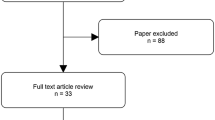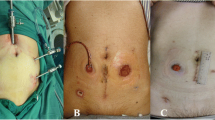Abstract
Background
Pelvic exenteration is potentially curative for locally advanced and recurrent pelvic cancers. Evolving technology has facilitated the use of minimally invasive surgical (MIS) techniques in selected cases. We aimed to compare outcomes between open and MIS pelvic exenteration.
Methods
A review of comparative studies was performed. Firstly, we evaluated the differences in surgical techniques with respect to operative time, blood loss, and margin status. Secondly, we assessed differences in 30-day morbidity and mortality rates, and length of hospital stay.
Results
Four studies that directly compared open and MIS exenteration were included. Analysis was performed on 170 patients; 78.1% (n = 133) had open pelvic exenteration, while 21.8% (n = 37) had a MIS exenteration. The median age for open exenteration was 57.7 years versus 63 years for MIS exenteration. Even though the operative time for MIS exenteration was 83 min longer (p < 0.001), it was associated with a median of 1,750mls less blood loss. The morbidity rate for MIS exenterative group was 56.7% (n = 21/37) versus 88.5% (n = 85/96) in the open exenteration group, with pooled analysis observing a 1.17 relative risk increase in 30-day morbidity (p = 0.172) in the open exenteration group. In addition, the MIS cohort had a 6-day shorter length of hospital stay (p = 0.04).
Conclusion
MIS exenteration can be performed in highly selective cases, where there is favourable patient anatomy and tumour characteristics. When feasible, it is associated with reduced intra-operative blood loss, shorter length of hospital stay, and reduced morbidity.






Similar content being viewed by others

References
Zoucas E, Frederiksen S, Lydrup ML, Mansson W, Gustafson P, Alberius P (2010) Pelvic exenteration for advanced and recurrent malignancy. World J Surg 34:2177–2184
Brunschwig A (1948) Complete excision of pelvic viscera for advanced carcinoma; a one-stage abdominoperineal operation with end colostomy and bilateral ureteral implantation into the colon above the colostomy. Cancer 1(2):177–183
Butcher HR Jr, Spjut HJ (1959) An evaluation of pelvic exenteration for advanced carcinoma of the lower colon. Cancer 12(4):681–687
Hockel M, Dornhofer N (2006) Pelvic exenteration for gynaecological tumours: achievements and unanswered questions. Lancet Oncol 7:837–847
Pawlik TM, Skibber JM, Rodriguez-Bigas MA (2005) Pelvic exenteration for advanced pelvic malignancies. Ann Surg Oncol 13(5):612–623
Brown KGM, Koh CE, Solomon MJ, Qasabian R, Robinson D, Dubenec S (2015) Outcomes after en bloc iliac vessel excision and reconstruction during pelvic exenteration. Dis Colon Rectum 58:850–856
Brown KGM, Solomon MJ, Koh CE (2017) Pelvic exenteration surgery: the evolution of radical surgical techniques for advanced and recurrent pelvic malignancy. Dis Colon Rectum 60:745–754
Rodriguwz-Bigas MA, Petrelli NJ (1996) Pelvic exenteration and its modifications. Am J Surg 171(2):293–298
Lopez MJ, Standiford SB, Skibba JL (1994) Total pelvic exenteration. A 50-year experience at the Ellis Fischel Cancer Center. Arch Surg 129(4):390–395 (discussion 5–6).
Yu HH, Leong CH, Ong GB (1976) Pelvic exenteration for advanced pelvic malignancies. Aust N Z J Surg 46(3):197–201
Dobrowsky W, Schmid AP (1985) Radiotherapy of presacral recurrence following radical surgery for rectal carcinoma. Dis Colon Rectum 28(12):917–919
Ferenschild FTJ, Vermaas M, Verhoef C, Ansink AC, Kirkels WJ, Eggermont AMM, deWilt JHW (2009) Total pelvic exenteration for primary and recurrent malignancies. World J Surg 33:1502–1508
Feigel A, Sylla P (2016) Role of minimally invasive surgery in the reoperative abdomen or pelvis. Clin Colon Rectal Surg 29(2):168–180
Keller DS, Flores-Gonzalez JR, Ibarra S, Haas EM (2016) Review of 500 single incision laparoscopic colorectal surgery cases—lessons learned. World J Gastroenterol 22(2):659–667
Medlin EE, Kushner DM, Barroilhet L (2015) Robotic surgery for early stage cervical cancer: evolution and current trends. J Surg Oncol 112(7):772–781
Moher D, Liberati A, Tetzlaff J, Altman DG, Group P (2009) Preferred reporting items for systematic reviews and meta-analyses: the PRISMA Statement. Open medicine: a peer-reviewed, independent. Open-Access J 3(3):e123–e130
Srinivasaiah N, Malietzis G, Jenkins I (2015) Use of laparoscopy in pelvic exenteration surgery. PROSPERO 2015 CRD42015023284. http://www.crd.york.ac.uk/PROSPERO/display_record.php?ID=CRD42015023284
Faraone SV (2008) Interpreting estimates of treatment effects: implications for managed care. P&T 33(12):700–711
Hozo SP, Djulbegovic G, Hozo I (2005) Estimating the mean and variance from the median, range, and the size of a sample. BMC Med Res Methodol 5:13
Winters BR, Mann GN, Louie O, Wright JL (2015) Robotic total pelvic exenteration with laparoscopic rectus flap: Initial experience. Case Rep Surg 2015:835425
Yang K, Cai L, Yao L, Zhang Z, Zhang C, Wang X, Tang J, Li X, He Z, Zhou L (2015) Laparoscopic total pelvic exenteration for pelvic malignancies: the technique and short-time outcome of 11 cases. World J Surg Oncol 15:13:301
Uehara K, Nakamura H, Yoshino Y, Arimoto A, Kato T, Yokoyama Y, Ebata T, Nagino M (2016) Initial experience of laparoscopic pelvic exenteration and comparison with conventional open surgery. Surg Endosc 30(1):132–138
Martinez A, Filleron T, Vitse L et al (2011) Laparoscopic pelvic exenteration for gynaecological malignancy: is there any advantage? Gynecol Oncol 120(3):374–379
Austin KK, Solomon MJ (2009) Pelvic exenteration with en bloc iliac vessel resection for lateral pelvic wall involvement. Dis Colon Rectum 52(7):1223–1233
Heriot AG, Byrne CM, Lee P, Dobbs B, Tilney H, Solomon MJ et al (2008) Extended radical resection: the choice for locally recurrent rectal cancer. Dis Colon Rectum 51(3):284–291
Nielsen M, Rasmussen P, Lindegaard J et al (2012) A 10-year experience of total pelvic exenteration for primary advanced and locally recurrent rectal cancer based on prospective database. Colrectal Dis 14(9):1076–1083
Ike H, Shimada H, Yamaguchi S et al (2003) Outcomes of total pelvic exenteration for primary rectal cancer. Dis Colon Rectum 46:474–480
Bretagnol F, Dedieu A, Zappa M, Guedj N, Ferron M, Panis Y (2011) T4 colorectal cancer: is laparoscopic resection contraindicated? Colorectal Dis 13(2):138–143
Healy KA, Gomella LG (2013) Retropubic, laparoscopic, or robotic radical prostatectomy: is there any real difference? Semin Oncol 40(3):286–296
Bogani G, Cromi A, Serati M, Di Naro E, Casarin J, Pinelli C, Ghezzi F (2014) Laparoscopic and open abdominal staging for early-stage ovarian cancer: our experience, systematic review, and meta-analysis of comparative studies. Int J Gynecol Cancer 24(7):1241–1249
Ferron G, Pomel C, Martinez A et al (2012) Pelvic exenteration: current state and perspectives. Gynecol Obstet Fertil 40:43–47
Pomel C, Rouzier R, Pocard M, Thoury A et al (2003) Laparoscopic total pelvic exenteration for cervical cancer relapse. Gynecol Oncol 91:616–618
Puntambekar S, Kudchadar RJ, Gurjar AM, Sathe RM et al (2006) Laparoscopic pelvic exenteration for advanced pelvic cancers: a review of 16 cases. Gynecol Oncol 102:513–516
Mukai T, Akiyoshi T, Ueno M, Fukunaga Y, Nagayama S, Fujimoto Y, Konishi T, Ikeda A et al (2013) Laparoscopic total pelvic exenteration with en bloc lateral lymph node dissection after neoadjuvant chemoradiotherapy for advanced primary rectal cancer. Asian J Endosc Surg 6(4):314–317
Vasilescu C, Tudor S, Popa M, Aldea B, Gluck G (2011) Entirely robotic total pelvic exenteration. Surg Laparosc Endosc Percutaneous Tech 21(4):e200–e202
Gadkari Y, Puntambekar SP et al (2015) Our experience of laparoscopic anterior exenteration in locally advanced cervical carcinoma. J Min Invasive Gynecol 22:S1–S253
Puntambekar S, Lawande A, Desai R, Puntambekar S, Joshi GA, Joshi SN (2014) Initial experience of robotic anterior pelvic exenteration at a single institute. Int J Gynaecol Obstet 126(1):41–44
PelvEx Collaborative authors
Srinivasaiah N, Shekleton F, Kelly ME, Harji D, Malietzis G, Askari A, Aalbers AGJ, Alberda W, Antoniou A, Austin KK, Beets GL, Berg PL, Beynon J, Bosman SJ, Brunner M, Burger JWA, Campain N, Christensen HK, Coscia M, Colquhoun AJ, Coyne P, Daniels IR, Davies RJ, de Wilt JHW, Denost Q, Deutsch C, Dietz D, Duff M, Eglinton T, Fearnhead N, Frizelle FA, Garcia-Sabrido JL, George ML, Gentilini L, Griffiths B, Harris DA, Evans M, Heriot AG, Hohenberger W, Hoe CM, Holm T, Kanemitsu Y, Chan KKL, Kim H, Koh CE, Kok NF, Kontovounisios C, Law WL, Laurberg S, Lee P, Lydrup ML, Lynch AC, Martling A, Meijerink J, Mentha A, Merkel S, McDermott FD, McGrath JS, Nielsen MB, Nieuwenhuijzen GAP, Nilsson PJ, Abraham-Nordling M, O’Connell PR, Patsouras D, Poggioli G, Radwan RW, Rasheed S, Rasmussen PC, Rothbarth J, Rutten HJT, Sagar PM, Schizas AMP, Shida D, Smart NJ, Solomon MJ, Sorensen MM, Stocchi L, Tekkis PP, Tsukamoto S, Turner WH, Tuynman JB, van Ramshorst GH, van Zoggel D, Vasquez-Jimenez W, Verhoef C, Verstegen M, Wakeman C, Warrier S, Yip J, Winter DC, Jenkins JT.
Author information
Authors and Affiliations
Consortia
Ethics declarations
Conflict of interest
All PelvEx Collaborative authors declare no conflict of interest.
Additional information
PelvEx Collaborative—JT Jenkins, St Mark’s Hospital, London, email: mrianjenkins@icloud.com.
All PelvEx Collaborative members are co-authors and approved this submission. The list of authors is provided at the end of the article.
Rights and permissions
About this article
Cite this article
The PelvEx Collaborative. Minimally invasive surgery techniques in pelvic exenteration: a systematic and meta-analysis review. Surg Endosc 32, 4707–4715 (2018). https://doi.org/10.1007/s00464-018-6299-5
Received:
Accepted:
Published:
Issue Date:
DOI: https://doi.org/10.1007/s00464-018-6299-5



